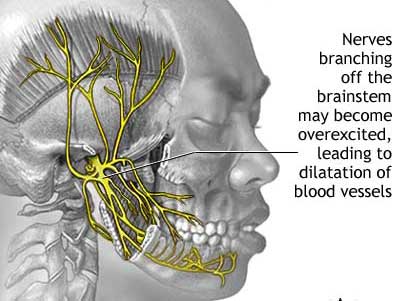
MIGRAINE
Migraine is a painful neurological condition, of which the most common symptom is an intense and disabling episodic headache. Migraine headaches are usually characterized by severe pain on one or both sides of the head. Absent serious head injuries, stroke, and tumors, the recurring severity of the pain indicates a vascular headache rather than a tension headache. Migraines are often accompanied by photophobia (hypersensitivity to Migraine is a frustrating chronic illness that is widespread in the population (10% diagnosed, 5% undiagnosed), with seriousness varying from a rare annoyance to a life-threatening daily experience. Treatments are typically expensive. Periodic or unpredictable disability can cause impoverishment due to patients' inability to work enough or to hold a job at all. Migraine’s secondary characteristics are inconsistent. Triggers precipitating a particular episode of migraine vary widely. The simplest treatment, applying warm/hot water or cold-water soaked cloths to the affected area of head, is contradictory — hot or cold can either increase or decrease pain, though it is consistent in the same patient. A particular migraine rescue drug may sometimes work and sometimes not work in the same patient. Some migraine types don't have pain or don't occur in the head. Available evidence suggests that migraine pain is one symptom of several to many disorders of the serotonergic control system, a dual hormone-neurotransmitter with numerous types of receptors. Two disorders, classic migraine with aura (MA, STG) common migraine without aura (MO, STG), are currently proved to be genetic. Additional migraine types are suspected and could be proved to be genetic. Migraine understood as several or many disorders could explain the inconsistencies, especially if a single patient has more than one genetic type. However, still other migraine types might be functionally acquired due to hormone organ disease or injury. Three-fourths of adult migraine patients are female, pre-pubertal migraine affects approximately equal numbers of boys and girls. This reveals the strong correlation to hormonal cycling and hormonal-related causes or triggers. Hormonal migraine is a likely consequence of periodically falling hormone levels causing reduction in protein biosynthesis of metabolic components including intestinal tract serotonin. All migraine knowledge reduces to the experiences of the individual migraineur. Every migraineur has a formula: when to sleep, what to eat, what herbs and supplements to use, what drugs to take, what triggers to avoid, and where to get advice. Prescription medicines are usually necessary, but doctors do not have all the answers. Because a migraineur's daily actions usually have so much effect on the frequency and intensity of illness, there is significant advantage to learning both the scientific medicine and folklore of migraine. Symptoms of Migraine The symptoms of a migraine may include:
Diagnosis of Migraine No tests are available to reliably diagnose a migraine. The doctor will make a determination, based on a physical examination and a thorough medical history, including triggers, symptoms and family history. Treatment of MigraineTreatment of migraines is directed at preventing attacks (prophylactic or preventive therapy) and alleviating them when they occur (abortive therapy). |
HOPES PINNED ON HIM
People from all over the world queue to see acupuncturist Leong Hong Tole who has made a name for himself in the world of traditional complementary medicine...Read Source: The Star Newspaper (Malaysia) |
| :: CLICK HERE FOR MORE VIDEO :: |
QUESTION |


